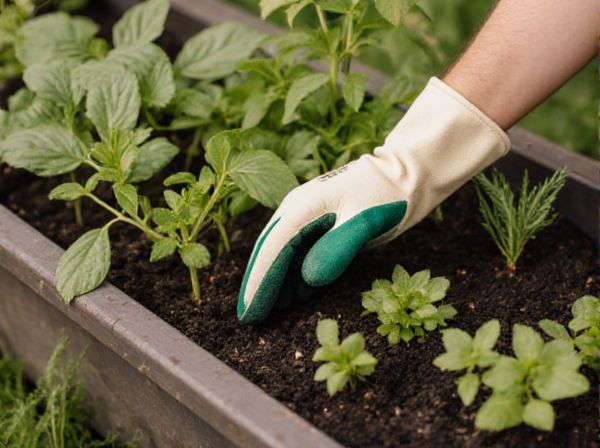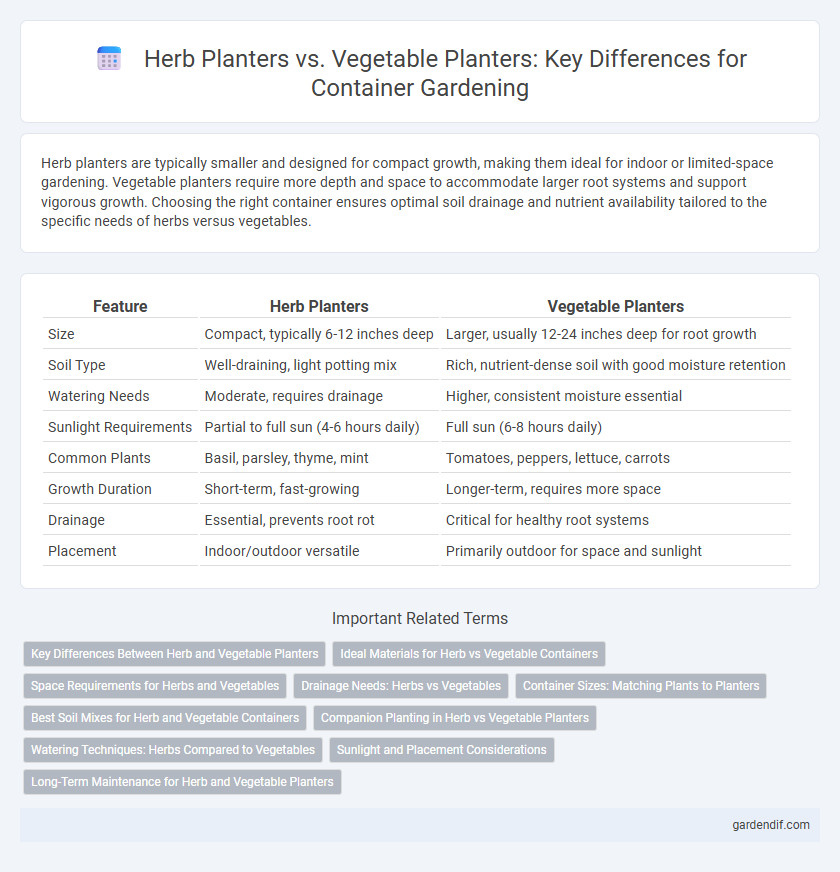
Herb planters vs vegetable planters Illustration
Herb planters are typically smaller and designed for compact growth, making them ideal for indoor or limited-space gardening. Vegetable planters require more depth and space to accommodate larger root systems and support vigorous growth. Choosing the right container ensures optimal soil drainage and nutrient availability tailored to the specific needs of herbs versus vegetables.
Table of Comparison
| Feature | Herb Planters | Vegetable Planters |
|---|---|---|
| Size | Compact, typically 6-12 inches deep | Larger, usually 12-24 inches deep for root growth |
| Soil Type | Well-draining, light potting mix | Rich, nutrient-dense soil with good moisture retention |
| Watering Needs | Moderate, requires drainage | Higher, consistent moisture essential |
| Sunlight Requirements | Partial to full sun (4-6 hours daily) | Full sun (6-8 hours daily) |
| Common Plants | Basil, parsley, thyme, mint | Tomatoes, peppers, lettuce, carrots |
| Growth Duration | Short-term, fast-growing | Longer-term, requires more space |
| Drainage | Essential, prevents root rot | Critical for healthy root systems |
| Placement | Indoor/outdoor versatile | Primarily outdoor for space and sunlight |
Key Differences Between Herb and Vegetable Planters
Herb planters are typically smaller and shallower, designed to accommodate the shallow root systems of herbs like basil and thyme, while vegetable planters require deeper and larger containers to support root development for plants such as tomatoes and carrots. Drainage is crucial for both types, but vegetable planters often need more robust watering systems to ensure consistent moisture levels due to their higher water requirements. Placement also differs, with herb planters favoring sunny indoor or outdoor spots and vegetable planters thriving best in outdoor environments with ample direct sunlight.
Ideal Materials for Herb vs Vegetable Containers
Herb planters benefit from porous materials like terracotta or ceramic that provide excellent drainage and breathability, fostering healthy root systems and preventing overwatering. Vegetable planters require durable, moisture-retentive materials such as heavy-duty plastic or wood composites to support deeper roots and retain consistent moisture levels. Choosing the right container material directly impacts plant growth, nutrient absorption, and overall yield for herbs and vegetables.
Space Requirements for Herbs and Vegetables
Herb planters typically require less space due to the compact growth habits of most herbs like basil, thyme, and parsley, making them ideal for small containers or windowsills. Vegetable planters need more room for root expansion and foliage, especially for larger crops like tomatoes, peppers, and leafy greens, often necessitating deeper and wider containers. Proper spacing in vegetable planters ensures adequate air circulation and nutrient access, critical for maximizing yield and preventing disease.
Drainage Needs: Herbs vs Vegetables
Herb planters generally require excellent drainage to prevent root rot, as many herbs thrive in well-drained, slightly dry soil conditions, while vegetable planters demand consistent moisture retention with adequate drainage to support deeper root systems and steady growth. Vegetables like tomatoes and peppers need soil that remains moist but not waterlogged, making drainage holes and well-aerated soil crucial in container design. Proper drainage in container planters ensures optimal oxygen flow to roots, reducing the risk of fungal diseases in both herbs and vegetables.
Container Sizes: Matching Plants to Planters
Herb planters typically require smaller containers, ranging from 6 to 12 inches in diameter, as herbs have shallow root systems and thrive in compact spaces. Vegetable planters need larger containers, often 12 to 24 inches or more, to accommodate extensive root growth and provide sufficient soil volume for nutrient absorption. Choosing the correct container size ensures optimal growth, moisture retention, and healthy plant development for both herbs and vegetables.
Best Soil Mixes for Herb and Vegetable Containers
Herb planters thrive in well-draining soil mixes rich in organic matter, such as a blend of peat moss, perlite, and compost, ensuring adequate moisture retention and aeration. Vegetable containers benefit from nutrient-dense soil composed of high-quality compost, vermiculite, and coconut coir, which supports root development and sustains prolonged nutrient availability. Both soil mixes require balanced pH levels between 6.0 and 7.0 to optimize plant growth and productivity in container gardening.
Companion Planting in Herb vs Vegetable Planters
Companion planting in herb planters enhances growth by pairing herbs like basil with tomatoes to repel pests and improve flavor, while vegetable planters benefit from pairing complementary plants such as carrots with onions to maximize space and reduce disease. Herbs often emit natural oils that deter harmful insects, creating a protective environment for adjacent vegetables in mixed planters. Strategically combining herbs and vegetables in container planters promotes healthier plants, increased yields, and efficient use of limited gardening space.
Watering Techniques: Herbs Compared to Vegetables
Herb planters require more frequent but lighter watering to prevent root rot, while vegetable planters often need deeper, less frequent watering to support robust root systems. Herbs thrive in well-drained soil with consistent moisture, whereas vegetables demand thorough watering to encourage deep root growth for nutrient absorption. Understanding these watering distinctions enhances plant health and maximizes yield in container gardening.
Sunlight and Placement Considerations
Herb planters thrive in partial to full sunlight, requiring at least 4-6 hours of light daily, making windowsills and balconies ideal for their placement. Vegetable planters generally demand more intense sunlight, often needing 6-8 hours to support growth, thus favoring south-facing spots or open patios. Strategic placement based on sunlight requirements maximizes growth potential and yields for both herb and vegetable container gardening.
Long-Term Maintenance for Herb and Vegetable Planters
Herb planters generally require less long-term maintenance than vegetable planters due to their smaller size and slower growth rates, making them ideal for low-maintenance gardening. Vegetable planters demand consistent watering, nutrient-rich soil replenishment, and pest management to sustain healthy plant development and maximize yield. Both types benefit from regular pruning and soil aeration to prevent diseases and promote robust root systems over time.
Herb planters vs vegetable planters Infographic

 gardendif.com
gardendif.com